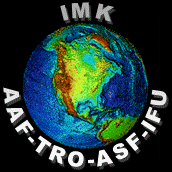Particle
Habit Imaging and
Polar Scattering
probe
Devoloped by our group in IMKAAF-KIT
PHIPS (Particle Habit
Imaging and Polar Scattering Probe) is an novel optical
sensor designed to measure, simultaneously, the 3D morphology and the
corresponding optical properties of individual cloud particles. It is composed
of two combined optical systems. The first system measures the polar scattered
light from cloud particles as they intersect a collimated CW laser. The second
system is a stereo imaging system composed of two identical camera-telescope
assemblies and a pulsed flash Laser.
The scattering part of PHIPS-AIDA enables
the measurement of polar scattered light of cloud
particles with an angular
resolution of 1° for forward scattering direction (from 1° to 10°) and 8° for the
side and back scattering directions (from 18° to 170°).
The two imaging assemblies are
separated by an angular distance of 60°.
PHIPS-AIDA
is the laboratory version of PHIPS-HALO which is one of the in situ ice particles
and water vapor instruments which have been
developed for the
German research aircraft "HALO"
 Abdelmonem
et. al. (2008)
Abdelmonem
et. al. (2008)
Photo Gallery of AIDA
campaign HALO02
PHIPS-HALO
is the airborne version of PHIPS.
It is composed of two combined optical systems. The first system
measures the polar scattered light from cloud particles as they
intersect a collimated CW laser (532nm, 300mW Class 3B). The scattered
light is collected by optical fibres and transmitted to a 32 channels
Photomultiplier (PMT). One of these channels is used as a trigger sensor
to catch the particles at the detection volume. The scattering signals
are conditioned by a Field-programmable array (FPGA) and stored on a
solid state hard disk (SS-HD). The second system is a stereo imaging
system composed of two identical camera-telescope assemblies and a
pulsed flash Laser (690nm, 400W, Class 4). The two imaging assemblies
are separated by an angular distance of 120°. The images are produced as
particles shadows on the CCD of each camera and stored on the same
SS-HD. The particles are illuminated by the flash laser using a Y-like
fibre optic and two optical collimators. Both detection systems are
controlled by a mini-PC.
PHIPS-HALO
is designed to be used on the German DLR HALO GV-SP aircraft










